AMD Zen 3 Ryzen Deep Dive Review: 5950X, 5900X, 5800X and 5600X Tested
by Dr. Ian Cutress on November 5, 2020 9:01 AM ESTCPU Tests: Simulation
Simulation and Science have a lot of overlap in the benchmarking world, however for this distinction we’re separating into two segments mostly based on the utility of the resulting data. The benchmarks that fall under Science have a distinct use for the data they output – in our Simulation section, these act more like synthetics but at some level are still trying to simulate a given environment.
DigiCortex v1.35: link
DigiCortex is a pet project for the visualization of neuron and synapse activity in the brain. The software comes with a variety of benchmark modes, and we take the small benchmark which runs a 32k neuron/1.8B synapse simulation, similar to a small slug.
The results on the output are given as a fraction of whether the system can simulate in real-time, so anything above a value of one is suitable for real-time work. The benchmark offers a 'no firing synapse' mode, which in essence detects DRAM and bus speed, however we take the firing mode which adds CPU work with every firing.
The software originally shipped with a benchmark that recorded the first few cycles and output a result. So while fast multi-threaded processors this made the benchmark last less than a few seconds, slow dual-core processors could be running for almost an hour. There is also the issue of DigiCortex starting with a base neuron/synapse map in ‘off mode’, giving a high result in the first few cycles as none of the nodes are currently active. We found that the performance settles down into a steady state after a while (when the model is actively in use), so we asked the author to allow for a ‘warm-up’ phase and for the benchmark to be the average over a second sample time.
For our test, we give the benchmark 20000 cycles to warm up and then take the data over the next 10000 cycles seconds for the test – on a modern processor this takes 30 seconds and 150 seconds respectively. This is then repeated a minimum of 10 times, with the first three results rejected. Results are shown as a multiple of real-time calculation.
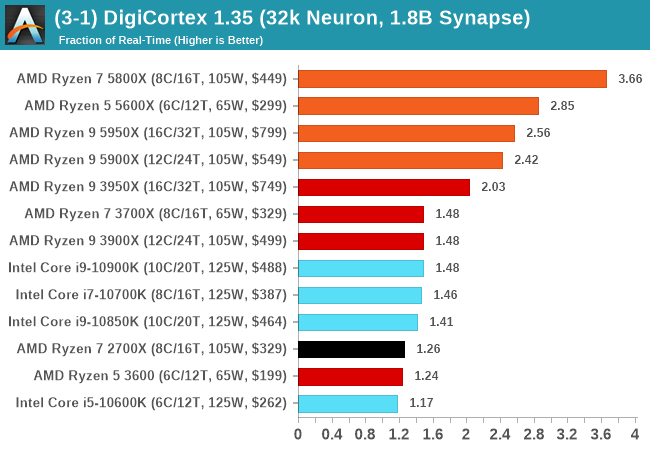
Dwarf Fortress 0.44.12: Link
Another long standing request for our benchmark suite has been Dwarf Fortress, a popular management/roguelike indie video game, first launched in 2006 and still being regularly updated today, aiming for a Steam launch sometime in the future.
Emulating the ASCII interfaces of old, this title is a rather complex beast, which can generate environments subject to millennia of rule, famous faces, peasants, and key historical figures and events. The further you get into the game, depending on the size of the world, the slower it becomes as it has to simulate more famous people, more world events, and the natural way that humanoid creatures take over an environment. Like some kind of virus.
For our test we’re using DFMark. DFMark is a benchmark built by vorsgren on the Bay12Forums that gives two different modes built on DFHack: world generation and embark. These tests can be configured, but range anywhere from 3 minutes to several hours. After analyzing the test, we ended up going for three different world generation sizes:
- Small, a 65x65 world with 250 years, 10 civilizations and 4 megabeasts
- Medium, a 127x127 world with 550 years, 10 civilizations and 4 megabeasts
- Large, a 257x257 world with 550 years, 40 civilizations and 10 megabeasts
DFMark outputs the time to run any given test, so this is what we use for the output. We loop the small test for as many times possible in 10 minutes, the medium test for as many times in 30 minutes, and the large test for as many times in an hour.
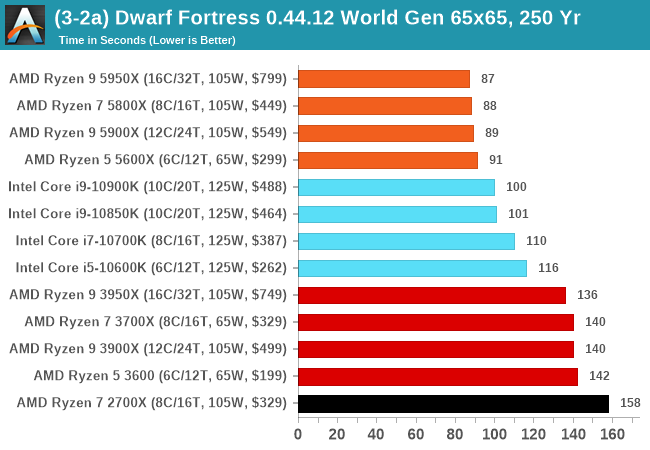
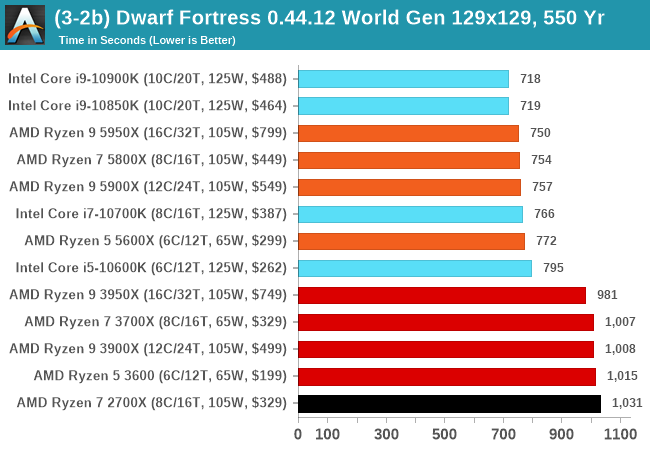
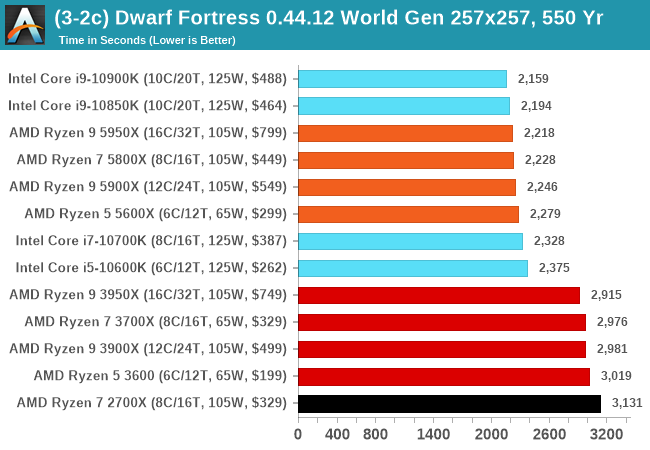
Dolphin v5.0 Emulation: Link
Many emulators are often bound by single thread CPU performance, and general reports tended to suggest that Haswell provided a significant boost to emulator performance. This benchmark runs a Wii program that ray traces a complex 3D scene inside the Dolphin Wii emulator. Performance on this benchmark is a good proxy of the speed of Dolphin CPU emulation, which is an intensive single core task using most aspects of a CPU. Results are given in seconds, where the Wii itself scores 1051 seconds.
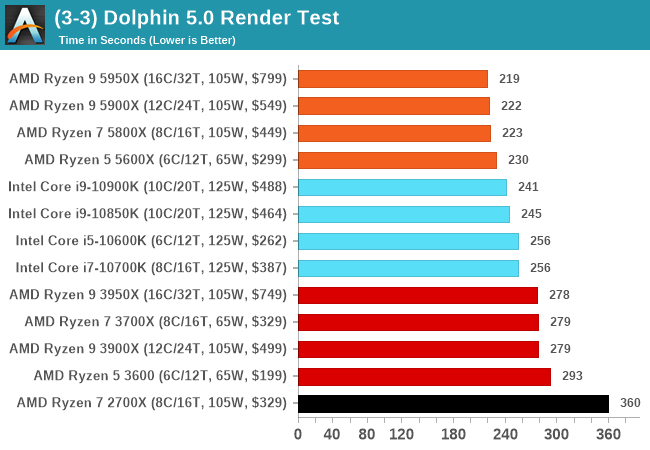












339 Comments
View All Comments
Jvanderlinde - Saturday, November 7, 2020 - link
Glad to read the 2700x is taken into account. The 5950X seems like a hell of an upgrade coming from that path. Gotta love AMD for what it's bin accomplishing in the last few years.Kallan007 - Saturday, November 7, 2020 - link
I just want to thank AMD for a lovely way to end 2020! I cannot wait for those AMD 6000 series card reviews! Good job as always AnandTech!Pumpkinhead - Saturday, November 7, 2020 - link
How is that possible that peak power for the 3700x having 8 cores is lower than for 3600 with 6 cores?nandnandnand - Saturday, November 7, 2020 - link
"Compared to other processors, for peak power, we report the highest loaded value observed from any of our benchmark tests."They selected the highest single wattage value from ANY of their tests. So at the same TDP, they should be very close to each other. I guess the point is to find the worst case scenario for each processor, rather than an average, to determine the power supply needed. Other reviews point to 3600 using less power on average:
https://www.tomshardware.com/reviews/amd-ryzen-5-3...
Pumpkinhead - Saturday, November 7, 2020 - link
>https://www.tomshardware.com/reviews/amd-ryzen-5-3...Interesting that 3700x being 1/3 faster in handbrake still draws only 13% more power, I always thought that in parallel workloads it power consumption scales linearly as you add more cores.
Even tho in AIDA stress test it draws 35% more power so peak consumption is different too, also look at the 5800x - draws almost twice as 5600x (also 6c vs 8c)
Kjella - Sunday, November 8, 2020 - link
It scales linearly until you hit the TDP, past that more cores lets you use a lower, more efficient frequency. As long as you can keep all cores loaded 8 cores on a 10W/core power budget will get less done than 16 cores at a 5W/core power budget even though 8*10 = 16*5. But with disabled cores you might have to run more of the chip, like the whole CCX to support 3 of 4 working cores. That will obviously be less efficient since the "overhead" has to be split by 3 instead of 4.Murilo - Saturday, November 7, 2020 - link
..and AMD price? ahahah.I want price!
psyclist80 - Saturday, November 7, 2020 - link
Im glad you guys added in Tiger Lake...very important data point. If it beat willow cove in its full implementation then its certainly going to beat the watered down 14nm version cypress cove and slay it on power efficiency.Im glad AMD has taken the crown back (last held 2003-2006)...as has been said in the past, the Empire will strike back...Hopefully Golden Cove can do that for Intel. That will face 5nm Zen 4 though...AMD looking strong for the next year or two!
Sushisamurai - Sunday, November 8, 2020 - link
apparently, looking at other reviews, there appears to be a performance uplift/downgrade (depends how you look at it) with the number of RAM sticks populated on the board (2 vs 4). I wonder how much of a difference it is with RAM speeds and memory stick population on the 5000 series.umano - Sunday, November 8, 2020 - link
I bought in june a 3800x and an x570 creator planning to upgrade to 5950x after zen 4 launches, but often, when we have more power, we find a way to crave for more. I work in fashion ph, for me the 35% bump in ps compared to my 3800x (bought because the price was the same as 3700) is a no brainer. It will also help me in capture one exports and zip compression. I did not think an upgrade so soon will benefit me so much, but you know life happens. Good job amd you made technology fun again